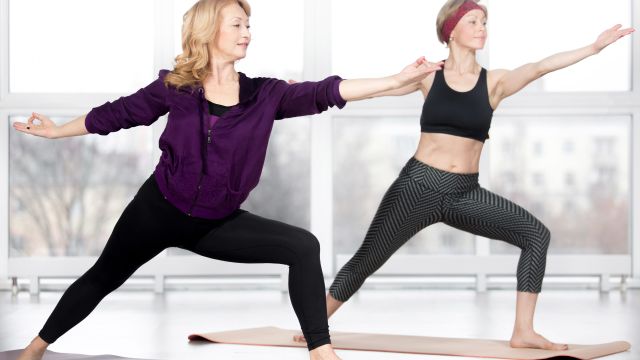Recently, while standing in the checkout line at my local Whole Foods, I glimpsed the yoga magazines for sale, each one with a cover image that was interchangeable with the next: A young woman with pale skin and pink cheeks sporting a posture that shows off her beauty and flexibility. I even caught myself thinking “gee I wish I could do that pose.”
And then came the reality check.
I have been teaching and practicing yoga for nearly 30 years, and I can assure you that being able to grab your foot behind your head doesn’t define whether or not you are practicing yoga. While doing postures can be enjoyable and even improve your own strength and flexibility the goal of yoga is actually meditation. Postures have value if they help to embody your awareness, quiet the mind and improve your overall health.
Different conditions and capacities
Everyone comes to yoga with different conditions and capacities. We all have a different set of circumstances we are working with including physical, mental, emotional and spiritual issues. Someone who is 20 may need a completely different set of postures and practices from someone who is 50. Someone who is using yoga to support healing will have a yoga routine that is different from someone who wants to lose weight or calm anxiety.
Many of the magazines and online images of yoga are appealing to the very young practitioner, often with the hope of selling the latest yoga clothes, yoga vacation or the promise of a happy life, but this kind of marketing may be speaking to a very small part of the population. It is clearly leaving out an important part of the yoga community, the older adult.
In fact, a 2016 Yoga in America study conducted by yoga alliance and yoga journal reveals that there are almost 14 million yoga practitioners over the age of 50 in the US.
Other yoga statistics compiled by Othmane Rahmouni found that 98% of practitioners consider themselves to be beginner or intermediate level practitioners.
Yoga is for a willing heart and mind
So where are the pictures that represent what it’s like to be a mature adult stepping onto the yoga mat? Where does the person who can’t touch their toes or grab their foot over their head fit? Those with a willing heart and mind but sometimes not-so-willing bodies are often not represented in the media. Because of this oversight, many of us get the message that “yoga is not for me.”
Rahmouni also sites these five reasons why people don’t try yoga:
- Not sure if it’s right for me
- Don’t know how to get started
- I don’t exercise
- I feel out of place
- My body isn’t right for yoga
Many of those who want to practice yoga can’t see themselves in the photographs portrayed in the media and they shouldn’t. By this account, yoga has been hijacked by the very young and incredibly fit. And yet yoga holds practices and techniques that can benefit everyone, and yoga has always been meant to be adapted to the individual.
Before the “yoga industry”
I myself was in my teens when I began my yoga practice. I was struggling with anxiety and found myself drawn to the feeling of peace and oneness I felt when I practiced, but when I started there was no “yoga industry.” Don’t get me wrong, there is something wonderful about the fact that yoga is now everywhere, but with that we have let the commercial industry define what it should look like. Even the yoga clothing industry is a billion dollar industry (2.23 billion in 2012).
Rewind 30 years and know that yoga used to be practiced in white drawstring cotton pants and with no mat at all, just the floor. No fluff and no flash. Showing off your poses was considered a lack of humility and a lack of understanding. Yes yoga has come a long way but it has also lost some of its depth and meaning. Traditionally yoga was reserved for the days when life in the world slowed down. Practitioners who had more time and fewer responsibilities with family and work set out on a spiritual journey, often spending long hours in the practice of meditation dedicated to the internal and meaningful practices of yoga.
They became the wise elders in the community, they carried on the tradition and became a beacon of light for others searching for peace and freedom from suffering. They were the keepers of the tradition.
Now yoga is accessible to everyone of all ages, from the very young to the very old. It can and should be adapted through all the phases of life. It has become part of many lifestyle change programs such as Ornish Lifestyle Medicine.
So the next time you see that beautiful image of a young flexible girl all tangled in knots, just know that you may not be doing that version of yoga, but your version is the practice that is just right for you. It’s your practice to, explore, learn and grow and it doesn’t need to look like anyone else’s. Yoga looks different on everyone and best of all it belongs to you.
Want more? Have new articles from Ornish-certified clinical team members sent straight to your inbox!






